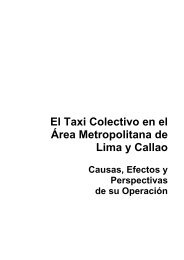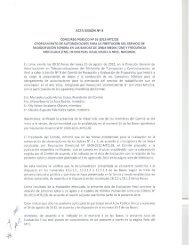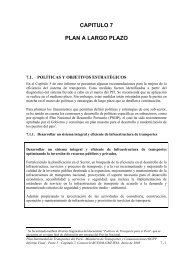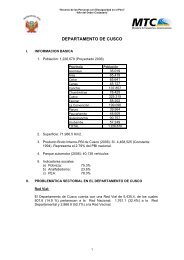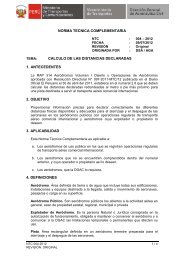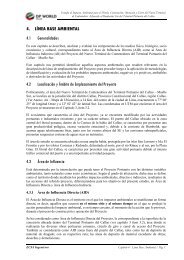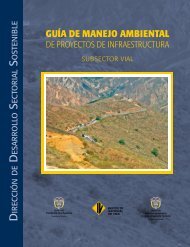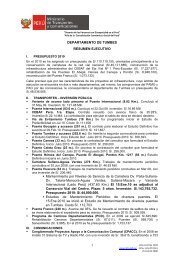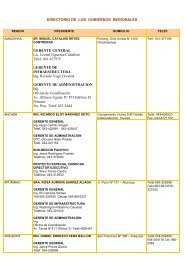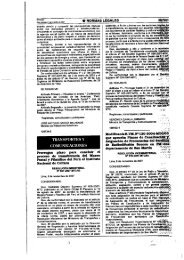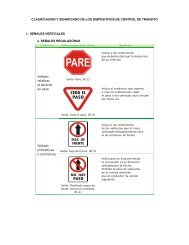descargar - Ministerio de Transportes y Comunicaciones
descargar - Ministerio de Transportes y Comunicaciones
descargar - Ministerio de Transportes y Comunicaciones
Create successful ePaper yourself
Turn your PDF publications into a flip-book with our unique Google optimized e-Paper software.
REPÚBLICA DEL PERÚ<br />
MTC – MINISTERIO DE TRANSPORTES Y COMUNICACIONES<br />
Soluciones Básicas<br />
sin Capa <strong>de</strong> Protección<br />
ING.CIV. OSVALDO AGUAYO<br />
SEMINARIO SOLUCIONES BASICAS PARA CAMINOS DE BAJO TRANSITO<br />
LIMA, PERÚ, 16 – 17 DE ABRIL, 2007
TEMARIO<br />
Soluciones Básicas<br />
con Capa <strong>de</strong> Protección<br />
Introducción<br />
Gama <strong>de</strong> Soluciones<br />
Construcción<br />
Conservación
TEMARIO<br />
Soluciones Básicas<br />
con Capa <strong>de</strong> Protección<br />
Introducción<br />
Gama <strong>de</strong> Soluciones<br />
Construcción<br />
Conservación
Calidad <strong>de</strong> Vida Rural<br />
Seguridad Vial<br />
Confortabilidad Cultivos
150 m antes 10 m antes<br />
durante<br />
200 m <strong>de</strong>spués<br />
Fotografías : DRV III Región
Conservación Tradicional<br />
Recién Terminado Dos meses <strong>de</strong> uso
Todo esto.....<br />
...... a pesar <strong>de</strong> los frecuentes<br />
reperfilados con motoniveladora<br />
( a veces cada 2 o 4 semanas)<br />
Bajo grado <strong>de</strong> satisfacción por las<br />
acciones <strong>de</strong>l Estado
Otros Países<br />
INTRODUCTION<br />
Background and Statement of Problem<br />
Out of the 3.8 million miles of road in the continental US, it is<br />
estimated that over 47 percent are aggregate and earth surfaced<br />
roads (Colorado Transportation Information Center. #5, 1989).<br />
Depending on which part of the country one is located the<br />
percentage of the road networks that is unpaved could vary between<br />
30 and 70 percent. For example, here in Colorado approximately 65<br />
percent of public roads are unpaved. Most of the unpaved roads are<br />
classified as low-volume roads and are located in the rural and<br />
forest areas of the country. While unpaved roads carry a small<br />
portion of the country's traffic, they provi<strong>de</strong> a vital first link in the<br />
county's economy.
• EEUU:<br />
Caso Norteamérica<br />
– 6.6 millones <strong>de</strong> Km<br />
– 47 % Ripio y Tierra (en Estados:entre 30 y 70%)<br />
– Problemas Polvo (seguridad vial) y mayores costos <strong>de</strong><br />
mantenimiento)<br />
– Tránsitos bajos pero impacto en economías local<br />
(condados)<br />
– Diferentes soluciones (asfaltos, cloruros, polímeros,<br />
arcillas (bentonita,....)
Technology Exchange Newsletter<br />
A Newsletter of the<br />
Minnesota Technology Transfer (T 2 ) Program, Local Technical Assistance Program (LTAP)<br />
July–September 2001<br />
Controlling dust and environmental impacts<br />
With 69,000 miles of aggregate road in Minnesota, controlling dust produced by traffic is a major concern. Besi<strong>de</strong>s increased<br />
expense for road maintenance and <strong>de</strong>creased visibility for drivers, one of the potential effects of dust, or particulate matter, is air<br />
pollution.<br />
Dust is one of the six primary pollutants monitored by the U.S. Environmental Protection Agency (EPA). It is harmful to human<br />
respiratory health and coats crops and homes. But are the negative environmental impacts of dust greater than the effects of pouring<br />
dust control chemicals onto aggregate roads?<br />
Cloruros <strong>de</strong> Sodio,<br />
Calcio y Magnesio<br />
Many dust control products are currently available: chlori<strong>de</strong>s (calcium, sodium, and magnesium), soybean soapstock, and bentonite<br />
are some of the options. Most research focuses on these products'; performance issues, but minimal research exists about<br />
environmental issues. Internet research, however, provi<strong>de</strong>d some further information about the latest products in the industry. (Ed.<br />
note: Minnesota T2 does not endorse particular products.)
Dust Control and Stabilization<br />
This document is disseminated un<strong>de</strong>r the sponsorship of the Department of Transportation in the interest of information exchange. The United<br />
States government assumes no liability for its contents or use thereof.<br />
Contents<br />
Éstos son los productos posibles más comúnmente usados<br />
•Resins a través <strong>de</strong>l país. Tres categorías: Cloruro <strong>de</strong>l calcio en<br />
•Natural Clays .<br />
•Asphalts<br />
•Soybean forma Oil <strong>de</strong> la escama o líquido, cloruro <strong>de</strong>l magnesio<br />
•Reduced generalmente Dusting en forma líquida, y el cloruro <strong>de</strong> sodio<br />
•Reduced "Whip Off" of Aggregate<br />
•Reduced Bla<strong>de</strong> Maintenance .<br />
(roadsalt). El cloruro <strong>de</strong> sodio raramente se utiliza y es el<br />
•Need for Good Surface Gravel .<br />
•Road Preparation<br />
•Applying menos the Product. eficaz. El cloruro <strong>de</strong> calcio y <strong>de</strong> magnesio pue<strong>de</strong>n<br />
•Optimum Moisture<br />
•Test Sections<br />
ser muy eficaces si se utilizan correctamente. Son<br />
productos higroscópicos que, en términos simples,<br />
significa que captan la humedad <strong>de</strong>l aire y la mantienen en<br />
la superficie <strong>de</strong>l camino. Son razonablemente simples <strong>de</strong><br />
utilizar.<br />
•Types of Stabilizers<br />
•Chlori<strong>de</strong>s .<br />
•Other Commercial Bin<strong>de</strong>rs<br />
•Benefits of Stabilization<br />
•Application Tips<br />
All gravel roads will give off dust un<strong>de</strong>r traffic. After all, they are unpaved roads that typically serve a low volume of traffic, and dust is usually an inherent<br />
problem. The amount of dust that a gravel road produces varies greatly. In areas of the country that receive a high amount of moisture, the problem is greatly<br />
reduced. Arid or semi-arid regions such as the <strong>de</strong>sert southwest and much of the great plains region in the USA are prone to long periods of dry weather. Similar<br />
regions around the globe can have similar weather patterns. Dust can really bring complaints in these areas if there are resi<strong>de</strong>nces located near the road and<br />
traffic is high.<br />
The quality and type of gravel also has some effect on the amount of dust. Some limestone gravels can dust severely while some glacial <strong>de</strong>posits of gravel with a<br />
portion of highly plastic clay can take on a strong binding characteristic that will resist dusting remarkably well. Still, in prolonged dry weather, there will be dust!<br />
Whether to provi<strong>de</strong> some type of dust control or not can be a hard <strong>de</strong>cision to make. Virtually all methods of dust control require annual treatment. The cost can<br />
be prohibitive if traffic volume is low. On the other hand, if traffic is high, the cost of dust control can more than pay for itself with the benefits of reduced<br />
material loss and reduced need for bla<strong>de</strong> maintenance. (28) At this point, many agencies will face pressure to pave the road. It may actually be a good economic<br />
<strong>de</strong>cision in the long run, especially if there is good indication that traffic will continue to increase in the future. However, never pave a road before it is ready!<br />
There is good information on making this <strong>de</strong>cision in Appendix D.<br />
Types of Stabilizers<br />
Chlori<strong>de</strong>s<br />
These are the most commonly used products across the country. They fall into three categories: Calcium Chlori<strong>de</strong> in flake or liquid form, Magnesium Chlori<strong>de</strong><br />
generally in liquid form, and Sodium Chlori<strong>de</strong> (road salt). Sodium is seldom used and is the least effective. Calcium and Magnesium Chlori<strong>de</strong> can be very effective<br />
if used properly. They are hygroscopic products which, in simplest terms, means they draw moisture from the air and keep the road surface constantly damp.<br />
They are reasonably simple to use.
Reduced "Whip Off" of<br />
Aggregate<br />
This is another economic bonus to dust control when it is working well.<br />
As mentioned earlier, when dust control products are working well, the<br />
fine material in the gravel cannot loosen and dust away. This also means<br />
that the stone portion of the gravel will tend to remain embed<strong>de</strong>d in the<br />
surface and will not be lost to the edge of the road or even whipped off<br />
onto the inslope from heavy traffic. Studies have shown that as much as<br />
one ton of aggregate per mile is lost each year for each vehicle that<br />
passes over a road daily. This means that a road carrying 200 vehicles<br />
per day will experience the loss of 200 tons of aggregate per mile each<br />
year. (7) Obviously this will vary with the amount of rainfall received, the<br />
quality of the gravel and other factors. Retaining aggregate is a good<br />
ad<strong>de</strong>d benefit to dust control.<br />
PÉRDIDA DE AGREGADOS<br />
Por cada vehículo que pasa, se pier<strong>de</strong> 0.6 tonelada <strong>de</strong><br />
agregado cada año por Km. TMDA 200 118<br />
tons./año/Km
Reduced Bla<strong>de</strong> Maintenance<br />
A road surface that remains tightly bound and stable will require much<br />
less bla<strong>de</strong> maintenance. The manufacturers of some dust control<br />
products highly recommend that the surface should not be bla<strong>de</strong>d at all<br />
after their products are applied. While extra blading, shaping and mixing<br />
is nee<strong>de</strong>d to prepare a road for dust control, the overall need for bla<strong>de</strong><br />
maintenance should be greatly reduced. This can be a great savings in<br />
equipment expense and labor. A county highway official once<br />
commented: "I don’t react to dust complaints. All gravel roads have<br />
dust. But I do react to high maintenance costs. When we have to<br />
regravel a road frequently and do bla<strong>de</strong> maintenance frequently, then<br />
it’s time to look at stabilizing the surface with Magnesium Chlori<strong>de</strong>.<br />
Reduced maintenance is what we’re after. Dust control is just a bonus!"
Application Tips<br />
The carbi<strong>de</strong>-tipped bits on a cutting edge can be a valuable tool in preparing a road for Chlori<strong>de</strong><br />
treatment. They penetrate the road and give a shallow scarifying effect to loosen and mix the existing<br />
gravel. This leaves a nice uniform loose layer of material on the surface.<br />
Soltar la superficie <strong>de</strong> la<br />
carpeta en unos 5 cm.<br />
This road has been prepared well for a liquid Magnesium Chlori<strong>de</strong> treatment. Notice the uniform, loose<br />
and nicely crowned surface looking over the hilltop. There is also good shoul<strong>de</strong>r drainage as well. This<br />
is an excellent example of road preparation.
Camión con barra regadora presurizada con sistema <strong>de</strong> aplicación<br />
computarizado que mi<strong>de</strong> el cloruro líquido con extrema precisión<br />
Antiguo esparcidor <strong>de</strong> fertilizantes. Calibrado<br />
con precisión. Corrosión: una vez ligado y<br />
compactado con la grava el efecto es muy bajo<br />
Grava muy seca <br />
prehume<strong>de</strong>cer antes <strong>de</strong><br />
aplicar cloruro. Gran mejoría
Canadá
1.3 Usage of Chlori<strong>de</strong>-Based Dust Suppressants in<br />
Canada<br />
Total consumption of chlori<strong>de</strong>-based dust suppressants in Canada is<br />
estimated at approximately 103 kt in 2000 (on a 100% basis). The majority<br />
of this consumption is calcium chlori<strong>de</strong>, which is used across Canada.<br />
Smaller amounts of magnesium chlori<strong>de</strong> are used as a dust<br />
suppressant, primarily in western Canada (i.e. 3 U.S. manufacturers of<br />
magnesium chlori<strong>de</strong> are located in the western U.S.). Historically, liquid<br />
solutions of calcium chlori<strong>de</strong> have generally been used as a dust<br />
suppressant. These liquid solutions typically contain 38% calcium chlori<strong>de</strong>.<br />
Recently, the flaked form of calcium chlori<strong>de</strong> has seen increased usage for<br />
dust control. The flaked form generally contains 78% calcium chlori<strong>de</strong> (the<br />
rest moisture). Magnesium chlori<strong>de</strong> is applied as a liquid, which contains<br />
approximately 28% magnesium chlori<strong>de</strong> (the rest mostly water). Research<br />
conducted for this study did not i<strong>de</strong>ntify the use of potassium chlori<strong>de</strong> or<br />
sodium chlori<strong>de</strong> as dust suppressants in Canada
Table 1 Overview of Chlori<strong>de</strong>-based<br />
Dust Suppressant Consumption in<br />
Canada, Year 2000<br />
(kilotonnes - 100% basis)<br />
Dust Suppressant Annual<br />
Consumption<br />
Calcium Chlori<strong>de</strong> 98<br />
Magnesium Chlori<strong>de</strong> 5<br />
Potassium Chlori<strong>de</strong> 0<br />
Sodium Chlori<strong>de</strong> 0<br />
Total 103
SUIZA<br />
Chlorure <strong>de</strong> magnésium<br />
contre la poussière<br />
Le Chlorure <strong>de</strong> magnésium est un produit <strong>de</strong><br />
première qualité pour lutter contre la poussière.<br />
Notre très longue expérience <strong>de</strong> son utilisation sur<br />
<strong>de</strong>s terrains non-asphaltés (chemins, places <strong>de</strong><br />
sports, places <strong>de</strong> parc et manèges) vous garantit un<br />
résultat impeccable pour lutter contre la poussière.<br />
En pério<strong>de</strong> très sèches, il est possible d‘améliorer<br />
l‘effet antipoussière du Chlorure <strong>de</strong> magnésium en<br />
arrosant la surface avec <strong>de</strong> l‘
MEXICO<br />
• Empleo <strong>de</strong> Cloruro <strong>de</strong> Calcio<br />
• En estado <strong>de</strong> Coahuila se ha comprobado<br />
su buen funcionamiento<br />
• Existe un Manual <strong>de</strong> Estabilización <strong>de</strong><br />
Caminos Revestidos con Cloruro <strong>de</strong> Calcio<br />
(Secretaría <strong>de</strong> <strong>Comunicaciones</strong> y Transporte)
Objetivo Técnico<br />
• Conservar los caminos mediante la adición<br />
<strong>de</strong> algún componente que le brin<strong>de</strong><br />
características <strong>de</strong> durabilidad y estabilidad<br />
a la carpeta <strong>de</strong> rodadura<br />
• Esto se pue<strong>de</strong> medir en términos <strong>de</strong>:<br />
– Polvo liberado al paso <strong>de</strong> vehículos<br />
– Regularidad superficial
Serviciabilidad<br />
Evolución Soluciones Básica vs Tradicional<br />
Solución<br />
Básica<br />
Reperfilados<br />
Tiempo
TEMARIO<br />
Soluciones Básicas<br />
sin Capa <strong>de</strong> Protección<br />
Introduccion<br />
Gama <strong>de</strong> Soluciones<br />
Construcción<br />
Conservación
Gama <strong>de</strong> Soluciones<br />
• Supresores <strong>de</strong> polvo<br />
– Cloruros<br />
– Aditivos comerciales<br />
• Estabilizadores<br />
– Mejoran las características estructurales <strong>de</strong>l<br />
suelo
......gráficamente....<br />
Carpeta Granular + Cloruro<br />
Expuesta al tránsito<br />
Base o Subbase mejorada con<br />
estabilizador químico mas<br />
protección asfáltica superficial
Cloruros<br />
• Son higroscópicos: afines con el agua<br />
• Captan agua <strong>de</strong>l medio ambiente y<br />
mantienen la carpeta húmeda<br />
• Cloruros:<br />
– <strong>de</strong> Sodio (NaCl) Sal común<br />
– <strong>de</strong> Magnesio hexahidratado (MgCl2.6H2O)<br />
Bischofita<br />
– <strong>de</strong> Calcio (CaCl2)
Sin Sal
Aditivos comerciales<br />
• Son aditivos fabricados especialmente para<br />
caminos<br />
•Se clasifican en:<br />
– Químicos<br />
– Poliméricos<br />
–Enzimáticos<br />
• Se los ha aplicado en sectores <strong>de</strong> prueba<br />
• Su comportamiento ha sido errático, sin mostrar<br />
aún evi<strong>de</strong>ncia <strong>de</strong> buenos resultados
Producto Recién Aplicado<br />
3 y 4 meses<br />
Las fotos correspon<strong>de</strong>n a distintos productos y no a mismos sectores <strong>de</strong> fotos superiores
IRI (m/km)<br />
24<br />
22<br />
20<br />
18<br />
16<br />
14<br />
12<br />
10<br />
8<br />
6<br />
4<br />
2<br />
0<br />
IRI INICIAL E IRI A LOS 6 MESES<br />
IRI v/s Producto<br />
Distintos productos probados <br />
MEDICIÓN DEL<br />
IRI<br />
inicial<br />
a los 6<br />
meses
IRI(K/KM)<br />
OTRA PRUEBA: IRI INICIAL E IRI A LOS 5 MESES<br />
14<br />
12<br />
10<br />
8<br />
6<br />
4<br />
2<br />
0<br />
IRI v/s Producto<br />
Distintos productos probados <br />
transcurrido<br />
1 mes<br />
transcurridos<br />
5 meses
Conclusión<br />
• El tema <strong>de</strong> ADITIVOS se continúa estudiando<br />
• Algunos productos funcionan bien con<br />
algunos tipos <strong>de</strong> suelos<br />
• Se <strong>de</strong>be hacer investigación <strong>de</strong> Química <strong>de</strong>l<br />
suelo<br />
• Lo más conveniente sería contratar por nivel<br />
<strong>de</strong> servicio por ej., controlar polvo y<br />
regularidad superficial
Estabilizadores<br />
• Aditivos Químicos que mejoran las características<br />
estructurales <strong>de</strong>l suelo<br />
• Su mayor beneficio: cuando no se cuenta con<br />
materiales <strong>de</strong> buena calidad en una distancia<br />
razonable (económica)<br />
• Se recomienda hacer balance: Costo <strong>de</strong><br />
estabilización química versus transporte <strong>de</strong><br />
material granular al camino<br />
• Muy recomendable terminar con una capa <strong>de</strong><br />
protección
TEMARIO<br />
Soluciones Básicas<br />
sin Capa <strong>de</strong> Protección<br />
Aspectos especiales<br />
Gama <strong>de</strong> Soluciones<br />
Construcción<br />
Conservación
Cloruro <strong>de</strong> Sodio
Cloruro <strong>de</strong> Sodio<br />
• Es higroscópico absorbe agua <strong>de</strong>s<strong>de</strong> el<br />
aire y la mantiene en la carpeta<br />
• Lo hace <strong>de</strong>s<strong>de</strong> una H.R. <strong>de</strong> 79 % y reduce la<br />
evaporación <strong>de</strong>l agua en 1,3 veces<br />
• Mo<strong>de</strong>radamente corrosiva al acero en<br />
solución diluida
Aplicación<br />
• La sal se pue<strong>de</strong> aplicar a granel o disuelta<br />
•I<strong>de</strong>al DISUELTA (se podría emplear ¼ <strong>de</strong> la<br />
cantidad a colocar a granel)<br />
•Problemas:<br />
– Solubilidad en laboratorio: 320 g/l<br />
– Solubilidad en terreno: + - 200 g/l (agitación + tiempo)<br />
– Cantidad a agregar a veces es > agua para<br />
Humedad óptima<br />
• Se ha optado por ponerla a granel
Bischofita<br />
(Cloruro <strong>de</strong> Magnesio Hexahidratado)
Cloruro <strong>de</strong> Magnesio<br />
• Es higroscópica absorbe agua <strong>de</strong>s<strong>de</strong> el<br />
aire y la mantiene en la carpeta<br />
• Lo hace <strong>de</strong>s<strong>de</strong> una H.R. <strong>de</strong> 32 %<br />
• Es posible disolver 150 Kg <strong>de</strong> bischofita<br />
(cloruro <strong>de</strong> magnesio hexahidratado) en<br />
100 Kg <strong>de</strong> agua
Aplicación<br />
• La Bischofita se aplica como salmuera<br />
• Se disuelve muy fácil en agua<br />
• Se aplica en el agua <strong>de</strong> amasado (Hóptima)<br />
•Se carga (con cargador) en estanque con agua<br />
• Se carga salmuera en camión regador<br />
• Resto <strong>de</strong> operaciones igual que una base
También se pue<strong>de</strong> aplicar empleando una recuperadora <strong>de</strong> caminos<br />
(recicladora) que va incorporando inmediatamente la salmuera<br />
Salmuera (MgCl2)<br />
Salmuera<br />
(MgCl2)
Punto <strong>de</strong> carguío<br />
camión regador<br />
Bischofita a<br />
estanque<br />
Estanque recibe<br />
agua y<br />
bischofita<br />
Punto <strong>de</strong> carguío<br />
camión regador<br />
Disolución<br />
Agua<br />
Estanque hechizo<br />
entre las rocas<br />
Control <strong>de</strong> la<br />
concentración<br />
<strong>de</strong> MgCl2
Vehículos a unos 90 Km / hr
Controles<br />
• A<strong>de</strong>más <strong>de</strong> los convencionales para la<br />
carpeta:<br />
– Medición <strong>de</strong> los Cloruros<br />
•Conductividad<br />
•Titulación Química<br />
– Medición <strong>de</strong> Polvo<br />
– Regularidad Superficial (IRI)
PONTIFICIA UNIVERSIDAD CATÓLICA DE CHILE<br />
Escuela <strong>de</strong> Ingeniería<br />
Departamento <strong>de</strong> Ingeniería y Gestión <strong>de</strong> la Construcción<br />
Cuantificación <strong>de</strong>l Polvo Generado por los Vehículos en<br />
Caminos No Pavimentados,<br />
Desarrollo Equipo MPC-1<br />
Componentes<br />
con Supresores <strong>de</strong> Polvo y Estabilizados<br />
Toma <strong>de</strong> Aire<br />
h/2<br />
Distancia<br />
Mínima<br />
h/2<br />
Felipe Halles A.<br />
27 Septiembre <strong>de</strong> 2004
Medición <strong>de</strong> conductividad cuantificación <strong>de</strong> cloruros<br />
(<strong>de</strong>sarrollado en Laboratorio Nacional <strong>de</strong> Vialidad, Chile)
Dósis <strong>de</strong> Bischofita [Kg/m 3 ]<br />
Dósis <strong>de</strong> Bischofita v/s Resistividad<br />
120<br />
100<br />
80<br />
60<br />
40<br />
20<br />
0<br />
100 1,000 10,000<br />
Resistividad [ohm*cm]<br />
Kilómetro r D<br />
[ohm*cm] Kg/m3<br />
70.06 563 40<br />
70.5 275 110<br />
70.72 395 80<br />
70.9 365 80<br />
70.1 398 80
Camino Forestal - Cloruro <strong>de</strong> Calcio
Se emplea en período estival<br />
En la región se produce CaCl2<br />
Riego Superficial
ESTABILIZACION<br />
PROES®<br />
TECNOLOGÍA DE ESTABILIZACIÓN QUÍMICA DE SUELOS
TEMARIO<br />
Soluciones Básicas<br />
con Capa <strong>de</strong> Protección<br />
Introducción<br />
Gama <strong>de</strong> Soluciones<br />
Construcción<br />
Conservación
Conservación<br />
• Si bien es cierto se <strong>de</strong>be hacer con menor<br />
frecuencia, NO DEJAR DE HACERLA!<br />
• En algunos casos los baches se hacen más duros<br />
que cuando no se aplica aditivos<br />
• Umbral <strong>de</strong> intervención: según Polvo y/o<br />
rugosidad<br />
• Consiste en Reperfilados, Reperfilados con<br />
adición <strong>de</strong>l compuesto original en menor<br />
cantidad, ya sea en riego <strong>de</strong> salmueras o a granel<br />
• Usualmente <strong>de</strong>spués <strong>de</strong> últimas lluvias (carpeta<br />
húmeda)
Para evitar acumulación <strong>de</strong><br />
agua se <strong>de</strong>be tener cuidado<br />
en la construcción <strong>de</strong> <strong>de</strong>jar un<br />
buen Bombeo (pendiente<br />
transversal) y ojala<br />
compactación con rodillo<br />
neumático
CONSERVACION PERIÓDICA
REPARACION DE BACHES CON BISCHOFITA<br />
Bacheo Granular<br />
con Bischofita
Osvaldo Aguayo<br />
Ingeniero Civil<br />
Santiago, Chile<br />
tel: (56-2) 449 -5646<br />
osvaldo.aguayo@gmail.com



